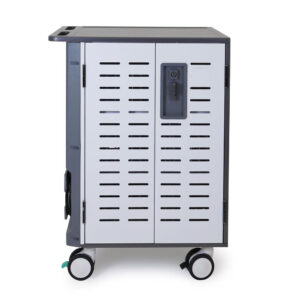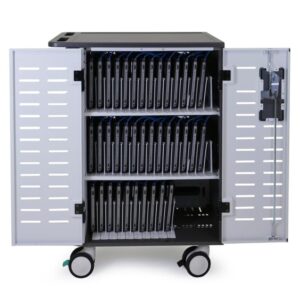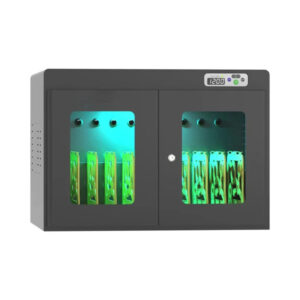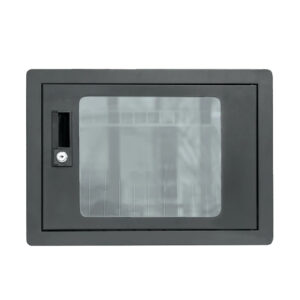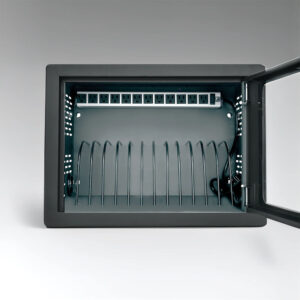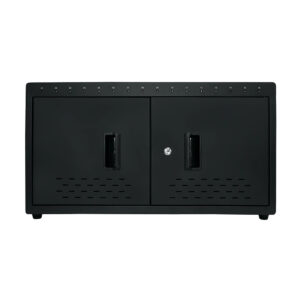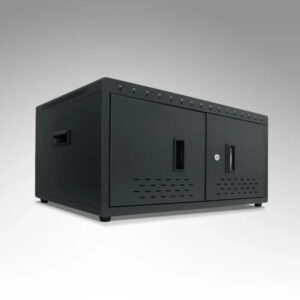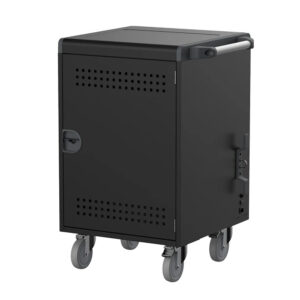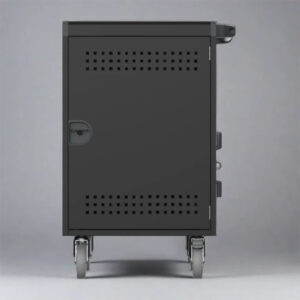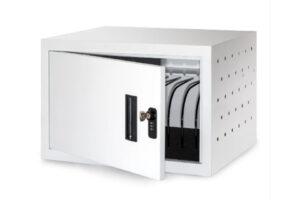Summary
Smart charging cabinets for modern offices are innovative storage solutions designed to enhance the efficiency and functionality of workplace environments by providing organized and secure charging for electronic devices. These cabinets are notable for their dual focus on aesthetics and functionality, integrating contemporary design elements with advanced technology to meet the evolving needs of modern workplaces. With features such as smart charging capabilities, user-friendly interfaces, and energy management systems, these cabinets facilitate seamless device access while promoting a clutter-free and organized workspace.
The growing adoption of smart charging cabinets is driven by their ability to address common workplace challenges, including device downtime and space optimization. By reducing “low battery anxiety,” these cabinets not only enhance employee productivity and morale but also contribute to cost savings for organizations by optimizing energy consumption. Furthermore, they support sustainable practices through the use of eco-friendly materials and energy-efficient technology, aligning with the increasing emphasis on corporate responsibility and environmental stewardship.
Despite their advantages, the implementation of smart charging cabinets has sparked discussions regarding cost versus benefits, installation complexities, and compliance with accessibility standards. Critics argue that the upfront investment may not yield immediate returns, particularly for smaller organizations, prompting a debate over the practicality of integrating these systems into existing office setups. Nonetheless, proponents assert that the long-term gains in productivity, employee satisfaction, and operational efficiency justify the initial expenditure, making them a strategic investment for businesses seeking to modernize their work environments.
As workplaces continue to evolve towards more flexible and technology-driven designs, smart charging cabinets are anticipated to play a crucial role in shaping the future of office spaces. Trends such as multi-device compatibility, enhanced user experience, and the integration of sustainable practices are expected to further drive the adoption and innovation of these charging solutions, positioning them as essential components in the modern office toolkit.
Table of Contents
Design
Aesthetic and Functional Considerations
The design of smart charging cabinets for modern office spaces must harmoniously blend aesthetics with functionality. Materials play a crucial role in this balance; for example, wooden cabinets provide warmth and elegance, while metallic frames introduce a contemporary urban feel. Glass elements can create an illusion of spaciousness, making them particularly advantageous in smaller office environments. Moreover, sustainable materials like reclaimed wood and bamboo can be utilized to minimize environmental impact, offering a unique character to office interiors while promoting ecological responsibility.
Ergonomics and User Experience
Incorporating ergonomic principles into the design of charging cabinets is essential for enhancing user experience. Features such as height-adjustable compartments and smooth surface finishes facilitate ease of use and accessibility, reducing the physical strain on employees. Ergonomic designs can lead to significant health benefits, minimizing the risk of musculoskeletal disorders and improving overall employee productivity and satisfaction.
Flexibility and Collaboration
The evolution of modern workspaces has shifted towards more flexible and collaborative environments, necessitating smart cabinet designs that accommodate various working styles. Mobile and modular designs can adapt quickly to different configurations, supporting both individual tasks and group collaborations. Additionally, implementing smart technology can streamline the operation of charging cabinets, allowing for efficient desk sharing and allocation through well-designed booking systems. This adaptability not only optimizes office space but also fosters a dynamic workplace that responds to the evolving needs of employees.
Personalization and Company Culture
The design of smart charging cabinets should reflect both individual user preferences and the overarching company culture. Allowing for customization—such as the inclusion of personal items, motivational quotes, and various lighting options—can create a more engaging and inspiring work environment. Striking a balance between standardization and personalization is key to making employees feel valued and motivated, thereby enhancing their overall productivity and satisfaction at work.
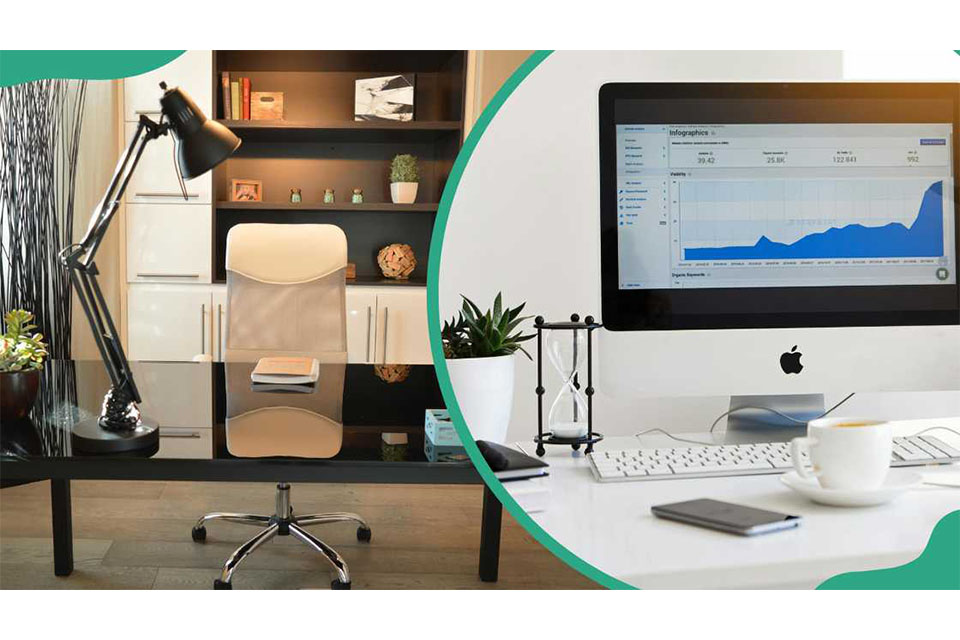
Functionality
Smart charging cabinets are designed to enhance workplace efficiency and productivity by providing versatile and secure storage for various electronic devices. These cabinets can accommodate up to 10 laptops or tablets with screens of up to 13 inches, featuring padded storage slots that protect devices from scratches and damage. The intelligent charging capabilities ensure efficient power distribution and safe charging of multiple devices simultaneously, addressing the power, data, and communication needs of modern office environments.
User-Friendly Design
The intuitive interfaces of smart charging cabinets allow for ease of use, making them accessible to all users regardless of their technical proficiency. Features like built-in cooling systems, intelligent locks, and surge protection prioritize the safety of valuable devices, ensuring that they are charged securely and efficiently. Additionally, these cabinets are equipped with multiple charging ports, including options for wireless charging, which simplifies the charging process for users and helps maintain a clutter-free workspace.
Energy Management and Smart Features
Dynamic load management (DLM) is a critical aspect of smart charging cabinets, enabling them to manage power distribution effectively. This feature not only protects local grids from peak loads but also optimizes energy consumption in office settings. The integration of cloud connectivity allows real-time monitoring of charging metrics and device status, enhancing the overall management of the charging network and supporting energy management initiatives within organizations.
Versatile Charging Solutions
Smart charging cabinets are compatible with a variety of devices, including laptops, tablets, and smartphones, making them versatile solutions for diverse workplace needs. As workplaces evolve, these cabinets adapt by incorporating the latest technologies and innovations, such as wireless charging options and compatibility with various charging standards, thereby meeting the dynamically changing demands of modern office spaces.
By combining security, efficiency, and user-friendly designs, smart charging cabinets play a vital role in creating a functional and stylish office environment that fosters productivity and accommodates the needs of employees.

Benefits
Enhanced Device Readiness
One of the primary benefits of smart charging cabinets is their ability to reduce device downtime. By ensuring that electronic devices are always charged and organized, these cabinets minimize disruptions caused by low battery levels or misplaced items. This reliability is crucial in maintaining workflow efficiency, especially in settings such as schools and healthcare facilities where timely access to technology is critical.
Improved Employee Productivity
Charging cabinets can significantly boost employee productivity by facilitating efficient access to power for personal devices. In workplaces where employees can charge their smartphones or laptops conveniently, the time spent searching for outlets or waiting for devices to charge is reduced. This allows staff to focus more on their tasks rather than on charging logistics.
Increased Employee Morale
Providing charging solutions contributes to enhanced employee morale. By alleviating “low battery anxiety,” companies can create a more supportive work environment. When employees feel that their needs are met, including the ability to keep their devices charged, they tend to exhibit higher levels of satisfaction and engagement at work, ultimately leading to better attendance records and customer service.
Cost Efficiency
Implementing smart charging solutions can lead to cost savings for businesses. By managing charging times and reducing unnecessary energy consumption, companies can lower their electricity costs. Moreover, less time spent away from workstations looking for charging solutions means more productive hours for employees.
Advanced Safety Features
Modern charging cabinets are designed with advanced safety mechanisms, including overload protection and surge damage prevention, ensuring that devices are charged safely. This focus on safety not only protects valuable technology assets but also provides peace of mind for employees and employers alike.
Space Optimization
Charging cabinets are designed to maximize space efficiency while providing a sleek, organized solution for device storage and charging. This design is particularly beneficial in modern offices where real estate is at a premium. By consolidating charging stations into a single unit, companies can maintain a clutter-free workspace, fostering a more organized and inviting environment.

Installation
Preliminary Considerations
Before proceeding with installation, it is crucial to assess the specific site conditions and any potential restrictions that may be imposed by local authorities or site owners. Engaging with key stakeholders early in the process can help identify necessary permits or zoning plans that must be adhered to, thereby avoiding delays that could incur additional costs.
Space Evaluation
It is important to evaluate the installation space to guarantee that it is both adequate and easily accessible for users. Considerations should include not just the physical dimensions of the area but also the convenience of access to power sources. For instance, Level 2 chargers typically require professional installation, which may involve additional planning and coordination.
Choosing the Right Charging Cabinet
When selecting a charging cabinet, it is beneficial to look for features that enhance usability, such as smart capabilities that allow for Wi-Fi connectivity, scheduling options, and energy tracking. These features can improve the overall efficiency of charging operations and can integrate with existing home or office energy management systems if applicable.
Budget and Long-term Costs
Evaluating the budget for both initial acquisition and installation of the charging cabinets is essential. In addition to the upfront costs, considering the long-term energy expenses is also important. Smart chargers that support off-peak charging can provide significant savings over time, making them a cost-effective choice for modern offices.
Accessibility Compliance
Entities subject to the Americans with Disabilities Act (ADA) must ensure that the installation of charging cabinets complies with accessibility requirements. This includes ensuring that a reasonable number of chargers are accessible to people with disabilities, in line with standards set forth by the Access Board. Regular updates on these standards may be issued, and businesses should remain informed about compliance guidelines to avoid legal issues.
By following these guidelines and considerations, organizations can effectively install smart charging cabinets that meet both their operational needs and regulatory requirements.

Comparison with Traditional Charging Solutions
Advantages of Smart Charging Cabinets
Smart charging cabinets offer significant advantages over traditional charging methods. They facilitate the simultaneous charging of multiple devices while reducing the clutter associated with loose cables. This centralized approach not only saves space but also streamlines access and management, as users can easily monitor the status of devices stored within.
Moreover, smart charging solutions often incorporate advanced security features, such as biometric access and remote monitoring, which traditional methods lack. These capabilities enable organizations to maintain oversight and protect sensitive materials, reducing the risk of theft or misuse.
Cost Efficiency and Environmental Benefits
From a cost perspective, smart charging cabinets can lead to significant savings. Effective power management within these systems can reduce energy costs by up to 35% compared to uncontrolled charging environments. Additionally, the implementation of smart charging solutions often results in improved operational efficiency for businesses.
User Experience and Productivity
The user experience is enhanced with smart charging cabinets, as they minimize the time employees spend managing and locating charging devices. By ensuring that all devices are readily charged and available, businesses can significantly increase productivity. Furthermore, features such as smart charging technology and real-time monitoring allow for more efficient use of resources compared to traditional charging methods.
Case Studies
Overview of Workplace Charging Implementations
Recent analyses have indicated that previous research on workplace charging primarily focused on qualitative evaluations through case studies and best practices aimed at assisting employers in optimizing their charging strategies. These case studies have illuminated the numerous advantages associated with modern charging solutions, particularly in the context of smart charging technologies.
Successful Smart Charging Implementations
Various organizations have successfully integrated smart charging systems, achieving notable cost efficiencies and enhanced operational performance.
- Company A implemented a smart charging system that led to a reduction in energy costs by 30% and decreased charging times by 25%.
- Company B shifted 80% of its charging activities to off-peak hours, alleviating stress on the electrical grid and saving approximately \$10,000 annually.
These examples highlight the impact that smart charging systems can have on reducing operational costs while promoting sustainability through efficient energy usage.
Challenges and Considerations
When adopting charging solutions, it is crucial to consider various factors that can influence the effectiveness and acceptance of these systems. Companies must manage charging demand effectively to maximize workplace charging efficiency. Implementing strategies to handle peak charging demand can further enhance cost-saving opportunities and minimize financial implications.
Moreover, ongoing operations and maintenance of the charging infrastructure are critical. Organizations are encouraged to partner with experienced service providers to ensure seamless integration and management of their charging stations. By adopting a comprehensive approach to installation and maintenance, companies can optimize their charging solutions, ensuring both functionality and satisfaction among employees.
Employee Engagement and Usage Monitoring
To foster a supportive environment for workplace charging, organizations should actively promote the benefits of their charging stations to employees. Highlighting advantages such as ease of use, safety, and cost savings can significantly increase employee engagement. Furthermore, implementing usage monitoring systems enables organizations to gather essential data on station utilization, empowering them to make informed decisions regarding scaling infrastructure.
Future Trends
Multi-Device Compatibility
The rise of multi-device hubs that support laptops, tablets, VR headsets, and drones is another notable trend. This flexibility ensures that charging solutions remain relevant as organizations expand their technology ecosystems.
Sustainability and Energy Management
Sustainability is increasingly becoming a standard feature in smart charging technology. Manufacturers are prioritizing recycled materials and designing products for disassembly and repair. This commitment aligns with corporate green initiatives while reducing environmental footprints.
Enhanced User Experience
Future innovations will focus on seamless integration with organizational software and smart home systems. Features such as real-time notifications, energy consumption insights, and off-peak charging schedules are becoming more common, enhancing convenience and efficiency.
Smart Charging for Electric Vehicles
In the realm of electric vehicle (EV) charging, advancements in smart charging technology are also anticipated. These systems will facilitate two-way communication between EVs and chargers, optimizing energy use and providing real-time data for fleet management. This will become increasingly relevant as businesses expand EV adoption.



